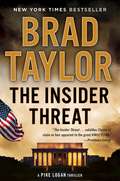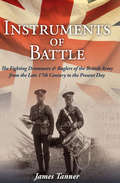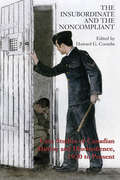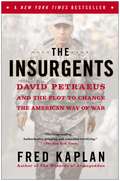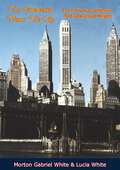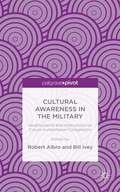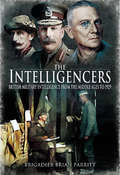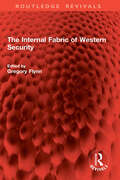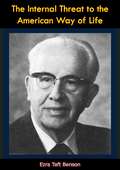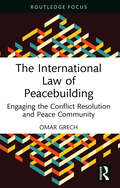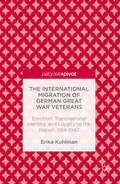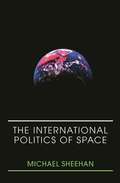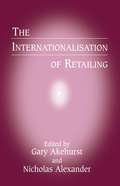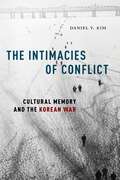- Table View
- List View
The Innocents Within
by Robert DaleyIn the thick of World War II, in a tiny town in the middle of France, Jewish refugees have found an enclave of conscience amidst a sea of hate. Led by the charismatic Pastor Favert, the townsfolk of Le Lignon risk their own lives to hide a constant stream of the persecuted. But when a badly wounded American pilot crashes nearby, their safety is compromised. The region's Reich commander is desperate to load the waiting deportation trains with Jews. Le Lignon, he knows, might be concealing enough refugees to fulfill his entire quota and secure his position within the SS. As the commander plots to seize his quarry, Vichy police descend on the village and demand the hidden pilot. Stretched to their limits, the people of Le Lignon must fortify themselves against the converging Nazi onslaught--or die trying.
The Insider Threat: A Pike Logan Thriller (A Pike Logan Thriller #8)
by Brad TaylorIn the eighth action-packed thriller in the New York Times bestselling Pike Logan series, ISIS, the most maniacal terrorist organization the modern world has ever seen, is poised to make their most audacious strike yet. The United States has anticipated and averted countless attacks from terrorist groups--thanks in large part to the extralegal counterterrorist unit known as the Taskforce. But in The Insider Threat, a much more insidious evil is about to shatter the false sense of safety surrounding civilized nations. While world powers combat ISIS on the battlefield, a different threat is set in motion by the group--one that can't be defeated by an airstrike. Off the radar of every Western intelligence organization, able to penetrate America or any European state, they intend to commit an act of unimaginable barbarity. Only Pike Logan and the Taskforce stand in the way of an attack no one anticipates, a grand deception that will wreak unthinkable chaos and reverberate throughout the Western world.
The Insiders’ Game: How Elites Make War and Peace (Princeton Studies in International History and Politics #208)
by Elizabeth N. SaundersHow elites shape the use of force in American foreign policyOne of the most widely held views of democratic leaders is that they are cautious about using military force because voters can hold them accountable, ultimately making democracies more peaceful. How, then, are leaders able to wage war in the face of popular opposition, or end conflicts when the public still supports them? The Insiders&’ Game sheds light on this enduring puzzle, arguing that the primary constraints on decisions about war and peace come from elites, not the public.Elizabeth Saunders focuses on three groups of elites—presidential advisers, legislators, and military officials—to show how the dynamics of this insiders&’ game are key to understanding the use of force in American foreign policy. She explores how elite preferences differ from those of ordinary voters, and how leaders must bargain with elites to secure their support for war. Saunders provides insights into why leaders start and prolong conflicts the public does not want, but also demonstrates how elites can force leaders to change course and end wars.Tracing presidential decisions about the use of force from the Cold War through the wars in Iraq and Afghanistan, Saunders reveals how the elite politics of war are a central feature of democracy. The Insiders&’ Game shifts the focus of democratic accountability from the voting booth to the halls of power.
The Insolence of Office: Slings and Arrows #3 (Star Trek: The Next Generation #3)
by William LeisnerA new six-part epic covering the first year of service of the U.S.S. Enterprise-E, leading up to the events of the hit movie Star Trek: First Contact. A major turning point in the lives of two of the Enterprise crew! Newly promoted Admiral Hayes gives La Forge a shocking ultimatum: his VISOR is a security risk, and he must either have it replaced with ocular implants or be transferred to a less-sensitive post. Meanwhile, Troi has some issues of her own. Though she knows that her mother, Lwaxana, recently remarried to the Tavnian named Jeyal, she was unaware of the subsequent pregnancy -- and now Lwaxana's about to give birth. To make matters worse, the Tevnian government has decided that, even though Lwaxana and Jeyal have since divorced, the child still belongs to them.
The Instructor: A Derek Harrington Novel (Derek Harrington #1)
by T. R. HendricksDive into The Instructor, former Army intelligence officer T. R. Hendricks' fast paced, action-packed debut thriller that's Jack Reacher meets Survivorman, the first novel in the Derek Harrington series!“Packed with action, tension, and humanity, The Instructor delivers.” —Mark Greaney, #1 New York Times bestselling author of Burner, a Gray Man Novel Derek Harrington, retired Marine Force Recon and SERE instructor, is barely scraping by teaching the basics of wilderness survival. His fledgling bushcraft school is on the cusp of going out of business and expenses are piling up fast. His only true mission these days? To get his ailing father into a full care facility and to support his ex-wife and their son. When one of his students presents him with an opportunity too good to be true—$20,000 to instruct a private group for 30 days in upstate New York—Derek reluctantly takes the job, despite his reservations about the group's insistence on anonymity. But it isn't long before the training takes an unexpected turn—and a new offer is made.Reaching out to an FBI contact to sound his concerns, Derek soon finds himself in deep cover, deep in the woods, embroiled with a fringe group led by a charismatic leader who will stop at nothing to get what he wants. When what he wants becomes Derek's head, the teacher is pitted against his students as Derek races against time to stop what could very well be the first attack by the domestic terrorist cell.“A pulse-pounding thriller. . . Hendricks delivers on all cylinders!” —Simon Gervais, former RCMP counterterrorism officer and bestselling author of The Last ProtectorAt the Publisher's request, this title is being sold without Digital Rights Management Software (DRM) applied.
The Instruments of Battle: The Fighting Drummers and Buglers of the British Army from the Late 17th Century to the Present Day
by James Tanner“The hitherto forgotten story of the development of the regimental band, mainly drummers and buglers. A rare piece of social history” (Books Monthly).The Instruments of Battle examines in detail the development and role of the British Army’s fighting drummers and buglers, from the time of the foundation of the army up to the present day. While their principal weapon of war was the drum and bugle—and the fife—these men and boys were not musicians as such, but fighting soldiers who took their place in the front line.The origins of the drum and bugle in the classical period and the later influence of Islamic armies are examined, leading to the arrival of the drum and fife in early Tudor England. The story proper picks up post-English Civil War. The drum’s period of supremacy through much of the eighteenth-century army is surveyed, and certain myths as to its use are dispelled. The bugle rapidly superseded the drum for field use in the nineteenth century—until developments on the battlefield consigned these instruments largely to barrack life and the parade ground. But there are surprising examples of the use of the bugle in the field through both world wars as the story is brought up to modern day and the instruments’ relegation to an almost exclusively ceremonial role.This is all set against a background of campaigns, battles, changing tactical methods, and the difficult processes of command and control on the battlefield. Interwoven is relevant comparison with other armies, particularly American and French. Stories of the drummers and buglers themselves provide social context to their place in the army.
The Insubordinate and the Noncompliant: Case Studies of Canadian Mutiny and Disobedience, 1920 to Present
by Howard CoombsThe Unwilling and the Reluctant: Theoretical Perspectives on Disobedience in the Military and The Apathetic and the Defiant: Case Studies of Canadian Mutiny and Disobedience, 1812-1919 are the first two volumes in a series devoted to disobedience issues in the Canadian military. Now with The Insubordinate and the Noncompliant, the trilogy is complete. Military leadership has both formal and informal dimensions. The formal leadership of any organization must ensure that it minimizes the divergence between institutional aims and the actions of informal leaders. When this separation occurs, the result is sometimes mutiny. These incidents of insubordination and noncompliance represent a form of dialogue between military personnel and their leadership. The Insubordinate and the Noncompliant offers a perspective on the Canadian experience with military mutiny in the twentieth century in an effort to provide relevant lessons for today.
The Insurgents: David Petraeus and the Plot to Change the American Way of War
by Fred KaplanA finalist for the Pulitzer Prize The inside story of the small group of soldier-scholars who—against fierce resistance from within their own ranks—changed the way the Pentagon does business and the American military fights wars.The Insurgents is the inside story of the small group of soldier-scholars, led by General David Petraeus, who plotted to revolutionize one of the largest, oldest, and most hidebound institutions—the United States military. Their aim was to build a new Army that could fight the new kind of war in the post–Cold War age: not massive wars on vast battlefields, but “small wars” in cities and villages, against insurgents and terrorists. These would be wars not only of fighting but of “nation building,” often not of necessity but of choice.Based on secret documents, private emails, and interviews with more than one hundred key characters, including Petraeus, the tale unfolds against the backdrop of the wars against insurgents in Iraq and Afghanistan. But the main insurgency is the one mounted at home by ambitious, self-consciously intellectual officers—Petraeus, John Nagl, H. R. McMaster, and others—many of them classmates or colleagues in West Point’s Social Science Department who rose through the ranks, seized with an idea of how to fight these wars better. Amid the crisis, they forged a community (some of them called it a cabal or mafia) and adapted their enemies’ techniques to overhaul the culture and institutions of their own Army.Fred Kaplan describes how these men and women maneuvered the idea through the bureaucracy and made it official policy. This is a story of power, politics, ideas, and personalities—and how they converged to reshape the twenty-first-century American military. But it is also a cautionary tale about how creative doctrine can harden into dogma, how smart strategists—today’s “best and brightest”—can win the battles at home but not the wars abroad. Petraeus and his fellow insurgents made the US military more adaptive to the conflicts of the modern era, but they also created the tools—and made it more tempting—for political leaders to wade into wars that they would be wise to avoid.
The Intellectual Versus The City: From Thomas Jefferson To Frank Lloyd Wright
by Morton Gabriel White Lucia WhiteAS CITIZENS OF A HISTORICALLY FRONTIER LAND, AMERICANS HAVE AN INHERENT DISTRUST OF THE CONFINEMENTS AND COMPLEXITIES OF THE CITY.But this ingrained romanticism about the natural life—the authors insist—does not fully explain American anti-urbanism. They point out that not only men like Emerson and Melville, but cosmopolitan figures such as Henry James, John Dewey and Theodore Dreiser have considered the American city a sinister place. The great architect Frank Lloyd Wright wanted to demolish the metropolis and replace it with a revolutionary form of living. Even the world-famous industrialist Henry Ford has said, “We shall solve the City Problem by leaving the City.”Tracing back across a century and a half, exploring the fields of art, philosophy, and sociology, Morton and Lucia White reveal what important Americans have said about their cities, and why. The authors suggest that modern city planners and social scientists have something to learn from these great dissenters, from their troubling wisdom and their urgent prophecies.From Thomas Jefferson to Frank Lloyd Wright our nation’s most distinguished artists, leaders, and intellectuals have proclaimed open hostility toward the city. Unlike the Englishman’s London or the Frenchman’s Paris, they have found nothing to love in the sprawling American metropolis. This significant and thoughtful study analyzes for the first time the major intellectual reactions to urbanism that have appeared through a century and a half of American history and offers some provocative conclusions as to why our cities have been the traditional object of prejudice, fear, and distrust.“A revealing analysis of American attitudes toward urbanization and urban life.”—New York Times“Excellent”—Harper’s“This lucid and imaginative book opens up new vistas in our understanding of our past and of our present.”—Arthur Schlesinger, Jr.
The Intellectual and the People in Egyptian Literature and Culture: Amāra and the 2011 Revolution
by Ayman A. El-DesoukyFeaturing chapters from social scientists directly engaged with the process, this volume offers a concise introduction to the U. S. military's effort to account for culture and increase its cultural capacity over the last decade. Contributors to this work consider some of the key challenges, lessons learned, and the limits of such efforts.
The Intelligencers: British Military Intelligence From the Middle Ages to 1929
by Brian ParrittIntelligence about the enemy is a fundamental part of any war or battle; knowledge of the enemys strength, dispositions and intentions are essential for success. This book reveals that for 250 years the British Army resolutely failed to prepare for war by refusing to establish a nucleus of soldiers in peace, trained to obtain intelligence in war. Although there were Scoutmasters and secret spy organizations such as Walsinghams in the 15th Century, in no major conflict from the Civil War of 1642, including the Peninsula, the Crimea, Burma, Egypt and South Africa and in the multitude of small wars that gained Britain an empire, was there any staff branch or unit specifically pre-established to gain intelligence or frustrate the enemy from obtaining intelligence. Yet the story of British military endeavor over 250 years is a remarkable story of individuals bravery, achievement and success. We read of the Scoutmaster whose role was to gather intelligence on the Kings enemies and of Walsinghams secret organization at the time of Elizabeth I. During the long years of war against France culminating in the Napoleonic Wars, spy masters developed on an ad hoc basis. In the Nineteenth Century, despite the power and reach of Empire, no central intelligence organization existed. Enterprising young officers worked wonders but failures such as those in the Boer War cost the Nation dearly. It took the reverses in the Great War to create an Intelligence Corps. But even that was disbanded postwar.
The Interceptors (Martin Falconer Thrillers)
by Max HennessyThe First World War is over. But Martin Falconer’s story is only just beginning.1919. Martin Falconer, a veteran airman while still in his teens and now adjusting to peacetime, is asked to go to Russia to fight the Bolsheviks. His answer? ‘Try and stop me.’The Great War had taken away much of Martin’s idealism, shown him the gruesome realities of battle. But the Russia of 1919, a chaotic, desperate country, shows him another sort of conflict, a civil war of great savagery and bitterness on both sides.Nothing is as simple as he had thought. But the danger and excitement as he flies over the Russian steppes will only further his extraordinary legacy.The continuation of the completely gripping WWI aviation thrillers, for fans of W. E. Johns, Alastair MacLean and Alan Evans.
The Internal Fabric of Western Security (Routledge Revivals)
by Josef Joffe Gregory Flynn Laurence Martin Yves Laulan Stefano SilvestriChanges in domestic economic and political conditions, together with a loss of confidence in the United States leadership produced serious problems within the Atlantic Alliance. The Internal Fabric of Western Security (first published in 1981) examines the effects of domestic change upon perceived security requirements and explores ways to deal with the problems that developed.Beginning with an examination of Allied and European relations, the book outlines external challenges to security that the Alliance faces in the 1980s and discusses internal problems that affect member nations’ ability to deal with them. Country studies of the four largest European members of the Alliance systematically examine domestic constraints on security policy and assess probable approaches for the 1980s. A more general analysis is offered on how this situation affects the Allies’ ability to work together in dealing with their common security problems. The need to integrate economic and military requirements is also discussed.
The Internal Threat to the American Way of Life
by Ezra Taft BensonThe Internal Threat to the American Way of Life was a talk given by Ezra Taft Benson at the Shrine Auditorium in Los Angeles, California on December 11, 1961. Benson had served as the 15th United States Secretary of Agriculture from January 21, 1953 to January 20, 1961.
The International Criminal Court in Ongoing Intrastate Conflicts
by Patrick S. WegnerIn recent decades, international courts have increasingly started investigating armed conflicts. However, the impact of this remains under-researched. Patrick S. Wegner closes this gap via a comprehensive analysis of the impact of the International Criminal Court in the Darfur and Lord's Resistance Army conflicts. He offers a fresh approach to peace and conflict studies, while avoiding the current quantitative focus of the literature and polarisation between critics and supporters of applying justice in conflicts. This is the first time that the impact of an international criminal court has been analysed in all its facets in two conflicts. The consequences of these investigations are much more complex and difficult to predict than most of the existing literature suggests. Recurrent claims, such as the deterrent effect of trials and the danger of blocking negotiations by the issuing of arrest warrants, are put to the test here with some surprising results.
The International Law of Peacebuilding: Engaging the Conflict Resolution and Peace Community (Studies in Conflict, Development and Peacebuilding)
by Omar GrechThis book contributes to the debate on the international law of post-conflict peacebuilding and suggests a need for closer connections between practitioners and lawyers.The work argues that significant benefits accrue when lawyers and conflict/peace practitioners, and scholars work with each other to develop a normative framework for building peace. It also attempts to bridge the divisions that exist between lawyers and the conflict resolution/peace community in the specific context of the international law of post-conflict peacebuilding. After introducing the key concepts of the international law of peacebuilding, the book explores aspects of the relationship between lawyers and peacebuilding practitioners and offers ideas about how this relationship might be improved. It then proceeds to identify some principles and processes developed by conflict resolution specialists that may inform and influence discrete parts of the international law of peacebuilding. The work concludes by identifying sites and ways in which international lawyers and conflict resolution/peace specialists may engage with each other to shape this branch of international law.This book will be of much interest to students of peace and conflict studies, international law and International Relations.
The International Migration of German Great War Veterans
by Erika KuhlmanThis book usesstory-telling to recreate the history of German veteran migration after theFirst World War. German veterans of the Great War were among Europe's mostvolatile population when they returned to a defeated nation in 1918, aftergreat expectations of victory and personal heroism. Some ex-servicemen chose toflee the nation for which they had fought, and begin their lives afresh in thenation against which they had fought: the United States.
The International Politics of Space: International Relations Theory And The Politics Of Space (Space Power And Politics Ser.)
by Michael SheehanThe year 2007 saw the fiftieth anniversary of the Space Age, which began with the launching of Sputnik by the Soviet Union in October 1957. Space is crucial to the politics of the postmodern world. It has seen competition and cooperation in the past fifty years, and is in danger of becoming a battlefield in the next fifty. The International Po
The International Relations of the Persian Gulf
by III F. Gregory GauseGregory Gause's masterful book is the first to offer a comprehensive account of the international politics in the Persian Gulf across nearly four decades. The story begins in 1971 when Great Britain ended its protectorate relations with the smaller states of the lower Gulf. It traces developments in the region from the oil 'revolution' of 1973-74 through the Iranian revolution, the Iran-Iraq war and the Gulf war of 1990-91 to the toppling of Saddam Hussein in the American-led invasion of Iraq in 2003, bringing the story of Gulf regional politics up to 2008. The book highlights transnational identity issues, regime security and the politics of the world oil market, and charts the changing mix of interests and ambitions driving American policy. The author brings his experience as a scholar and commentator on the Gulf to this riveting account of one of the most politically volatile regions on earth.
The International Workers’ Relief, Communism, and Transnational Solidarity: Willi Münzenberg in Weimar Germany (Palgrave Studies in the History of Social Movements)
by Kasper BraskénThe first major study on the making of new cultures, movements and public celebrations of transnational solidarity in Weimar Germany. The book shows how solidarity was used to empower the oppressed in their liberation and resistance movements and how solidarity networks transferred visions and ideas of an alternative global community.
The Internationalisation of Retailing
by Nicholas Alexander Gary AkehurstThe large retail enterprise which does not think on an international basis faces marginalization by competitors building international operations. Here, management researchers in the areas of international retailing offer an insight into the mechanisms of the internationalization of retailing.
The Internationalists: How a Radical Plan to Outlaw War Remade the World
by Scott J. Shapiro Oona A. HathawayA bold and provocative history of the men who fought to outlaw war and how an often overlooked treaty signed in 1928 was among the most transformative events in modern history.On a hot summer afternoon in 1928, the leaders of the world assembled in Paris to outlaw war. Within the year, the treaty signed that day, known as the Peace Pact, had been ratified by nearly every state in the world. War, for the first time in history, had become illegal the world over. But the promise of that summer day was fleeting. Within a decade of its signing, each state that had gathered in Paris to renounce war was at war. And in the century that followed, the Peace Pact was dismissed as an act of folly and an unmistakable failure. This book argues that that understanding is inaccurate, and that the Peace Pact ushered in a sustained march toward peace that lasts to this day. The Internationalists tells the story of the Peace Pact by placing it in the long history of international law from the seventeenth century through the present, tracing this rich history through a fascinating and diverse array of lawyers, politicians and intellectuals—Hugo Grotius, Nishi Amane, Salmon Levinson, James Shotwell, Sumner Welles, Carl Schmitt, Hersch Lauterpacht, and Sayyid Qutb. It tells of a centuries-long struggle of ideas over the role of war in a just world order. It details the brutal world of conflict the Peace Pact helped extinguish, and the subsequent era where tariffs and sanctions take the place of tanks and gunships. The Internationalists examines with renewed appreciation an international system that has outlawed wars of aggression and brought unprecedented stability to the world map. Accessible and gripping, this book will change the way we view the history of the twentieth century—and how we must work together to protect the global order the internationalists fought to make possible.
The Interpreter
by Alice KaplanNo story of World War II is more triumphant than the liberation of France, made famous in countless photos of Parisians waving American flags and kissing GIs, as columns of troops paraded down the Champs Élysées. Yet liberation is a messy, complex affair, in which cultural understanding can be as elusive as the search for justice by both the liberators and the liberated. Occupying powers import their own injustices, and often even magnify them, away from the prying eyes of home. One of the least-known stories of the American liberation of France, from 1944 to 1946, is also one of the ugliest and least understood chapters in the history of Jim Crow. The first man to grapple with this failure of justice was an eyewitness: the interpreter Louis Guilloux. Now, in The Interpreter, prize-winning author Alice Kaplan combines extraordinary research and brilliant writing to recover the story both as Guilloux first saw it, and as it still haunts us today. When the Americans helped to free Brittany in the summer of 1944, they were determined to treat the French differently than had the Nazi occupiers of the previous four years. Crimes committed against the locals were not to be tolerated. General Patton issued an order that any accused criminals would be tried by court-martial and that severe sentences, including the death penalty, would be imposed for the crime of rape. Mostly represented among service troops, African Americans made up a small fraction of the Army. Yet they were tried for the majority of capital cases, and they were found guilty with devastating frequency: 55 of 70 men executed by the Army in Europe were African American -- or 79 percent, in an Army that was only 8.5 percent black. Alice Kaplan's towering achievement in The Interpreter is to recall this outrage through a single, very human story. Louis Guilloux was one of France's most prominent novelists even before he was asked to act as an interpreter at a few courts-martial. Through his eyes, Kaplan narrates two mirror-image trials and introduces us to the men and women in the courtrooms. James Hendricks fired a shot through a door, after many drinks, and killed a man. George Whittington shot and killed a man in an open courtyard, after an argument and many drinks. Hendricks was black. Whittington was white. Both were court-martialed by the Army VIII Corps and tried in the same room, with some of the same officers participating. Yet the outcomes could not have been more different. Guilloux instinctively liked the Americans with whom he worked, but he could not get over seeing African Americans condemned to hang, Hendricks among them, while whites went free. He wrote about what he had observed in his diary, and years later in a novel. Other witnesses have survived to talk to Kaplan in person. In Kaplan's hands, the two crimes and trials are searing events. The lawyers, judges, and accused are all sympathetic, their actions understandable. Yet despite their best intentions, heartbreak and injustice result. In an epilogue, Kaplan introduces us to the family of James Hendricks, who were never informed of his fate, and who still hope that his remains will be transferred back home. James Hendricks rests, with 95 other men, in a U.S. military cemetery in France, filled with anonymous graves.
The Interrogation Rooms of the Korean War: The Untold History
by Monica KimA groundbreaking look at how the interrogation rooms of the Korean War set the stage for a new kind of battle—not over land but over human subjectsTraditional histories of the Korean War have long focused on violations of the thirty-eighth parallel, the line drawn by American and Soviet officials in 1945 dividing the Korean peninsula. But The Interrogation Rooms of the Korean War presents an entirely new narrative, shifting the perspective from the boundaries of the battlefield to inside the interrogation room. Upending conventional notions of what we think of as geographies of military conflict, Monica Kim demonstrates how the Korean War evolved from a fight over territory to one over human interiority and the individual human subject, forging the template for the US wars of intervention that would predominate during the latter half of the twentieth century and beyond.Kim looks at how, during the armistice negotiations, the United States and their allies proposed a new kind of interrogation room: one in which POWs could exercise their “free will” and choose which country they would go to after the ceasefire. The global controversy that erupted exposed how interrogation rooms had become a flashpoint for the struggles between the ambitions of empire and the demands for decolonization, as the aim of interrogation was to produce subjects who attested to a nation’s right to govern. The complex web of interrogators and prisoners—Japanese-American interrogators, Indian military personnel, Korean POWs and interrogators, and American POWs—that Kim uncovers contradicts the simple story in US popular memory of “brainwashing” during the Korean War.Bringing together a vast range of sources that track two generations of people moving between three continents, The Interrogation Rooms of the Korean War delves into an essential yet overlooked aspect of modern warfare in the twentieth century.
The Intimacies of Conflict: Cultural Memory and the Korean War
by Daniel Y. KimWinner, 2020 Peter C Rollins Prize, given by the Northeast Popular & American Culture AssociationEnables a reckoning with the legacy of the Forgotten War through literary and cinematic works of cultural memoryThough often considered “the forgotten war,” lost between the end of World War II and the start of the Cold War, the Korean War was, as Daniel Y. Kim argues, a watershed event that fundamentally reshaped both domestic conceptions of race and the interracial dimensions of the global empire that the United States would go on to establish. He uncovers a trail of cultural artefacts that speaks to the trauma experienced by civilians during the conflict but also evokes an expansive web of complicity in the suffering that they endured.Taking up a range of American popular media from the 1950s, Kim offers a portrait of the Korean War as it looked to Americans while they were experiencing it in real time. Kim expands this archive to read a robust host of fiction from US writers like Susan Choi, Rolando Hinojosa, Toni Morrison, and Chang-rae Lee, and the Korean author Hwang Sok-yong. The multiple and ongoing historical trajectories presented in these works testify to the resurgent afterlife of this event in US cultural memory, and of its lasting impact on multiple racialized populations, both within the US and in Korea. The Intimacies of Conflict offers a robust, multifaceted, and multidisciplinary analysis of the pivotal—but often unacknowledged—consequences of the Korean War in both domestic and transnational histories of race.

